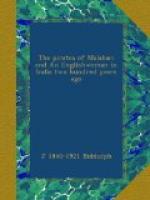CHAPTER III
THE RISE OF CONAJEE ANGRIA
Native piracy hereditary on the Malabar coast—Marco Polo’s account—Fryer’s narrative—The Kempsant—Arab and Sanganian pirates—Attack on the President—Loss of the Josiah—Attack on the Phoenix—The Thomas captured—Depredations of the Gulf pirates—Directors’ views—Conajee Angria—Attacks English ships—Destroys the Bombay—Fortifies Kennery—Becomes independent—Captures the Governor’s yacht—Attacks the Somers and Grantham—Makes peace with Bombay—His navy—Great increase of European and native piracy.
Europeans were not the only offenders. The Delhi Emperor, who claimed universal dominion on land, made no pretension to authority at sea. So long as the Mocha fleet did not suffer, merchants were left to take care of themselves. There was no policing of the sea, and every trader had to rely on his own efforts for protection. The people of the Malabar coast were left to pursue their hereditary vocation of piracy unmolested. The Greek author of the “Periplus of the Erythraean Sea,” who wrote in the first century of our era, mentions the pirates infesting the coast between Bombay and Goa. Two hundred years before Vasco da Gama had shown the way to India by sea, Marco Polo had told Europe of the Malabar pirates.
“And you must know that from this Kingdom of Melibar, and from, another near it called Gozurat, there go forth every year more than a hundred corsair vessels on cruize. These pirates take with them their wives and children, and stay out the whole summer. Their method is to join in fleets of 20 or 30 of these pirate vessels together, and then they form what they call a sea cordon, that is, they drop off till there is an interval of 5 or 6 miles between ship and ship, so that they cover something like a hundred miles of sea, and no merchant ship can escape them. For when any one corsair sights a vessel a signal is made by fire or smoke, and then the whole of them make for this, and seize the merchants and plunder them. After they have plundered they let them go, saying, ’Go along with you and get more gain, and that mayhap will fall to us also!’ But now the merchants are aware of this, and go so well manned and armed, and with such great ships, that they don’t fear the corsairs. Still mishaps do befal them at times."[1]
From the Persian Gulf to Cape Comorin the whole coast was beset by native pirates, and, with the rise of the Mahratta power, the evil increased. Petty chiefs sometimes levied blackmail by giving passports to those who would pay for them, claiming the right to plunder all ships that did not carry their passes; but often the formality was dispensed with. Owing to the paucity of records of the early days, and the more serious hostility of the Portuguese and Dutch, we hear little of the losses sustained




